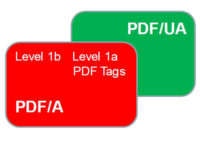PDF standards are not mutually exclusive

PDF/A, PDF/UA, PDF/X, PDF/VT, PDF/E and of course PDF itself are all certified ISO standards. Each of these variants fulfils certain requirements and is preferred in different sectors accordingly. However, these formats are not mutually exclusive, as the following two examples will show. Those of you who had the dubious pleasure of learning about set theory in school may recall the concept of intersecting sets…
In order to ensure that PDF files can be archived for long periods of time, the PDF/A format sets out certain requirements. In brief, these files must include all relevant information (they must be self-contained) and they may not include any active or insecure content. Level A, also known as the conformance level of PDF/A, also features the following characteristics required for content to be considered accessible:
- Tagged PDF
- Structure tree (hierarchy)
- Language details
- Unicode
This means that PDF/A Level A files can simultaneously meet the requirements of the PDF/UA standard for universally accessible content within PDF files.
This document represents a practical example of this principle.
This PDF file is considered fully accessible for current usage purposes. It can also later be archived as a PDF/A file. (If you open the example file in Adobe Reader and check the INFO menu, you will see the details of the PDF standards the file meets on the left-hand side.)
PDF/X – PDF/A
Likewise, a PDF/X file (the ISO standard used for printing) can also meet the requirements for PDF/A. This is because this format forbids content which could affect the print output or which would be unprintable, such as video and audio. Such elements are also forbidden under the PDF/A standard. Content which is mandatory in PDF/X, such as page size and trimming data, is “tolerated” under the PDF/A standard.
Here’s a simple, practical example of this principle.
PDF/X allows all printing houses to print this pad correctly, after which the same file can be stored in the company archive as a PDF/A file.
Conclusion
It’s very useful that ISO standards for PDF are not mutually exclusive, so there’s no need for multiple redundant versions of the same PDF file in many workflows. Our members offer a range of excellent PDF-based tools which allow users to create files which correctly meet multiple PDF standards simultaneously.
Source: The PDF Association
